You and Your Family published in 1949 is a fascinating booklet produced by the Canadian government’s National Health and Welfare department. It is a rich little 50 page document designed to explain the Family Allowance and to give advice about family income and children and their problems, to quote the cover.
From 1944-1992 the Family Allowance often called the Baby Bonus was paid monthly to mothers of children under 16 to support the raising of children. The first part of the book talks about how to apply for the allowance and sets out the amounts of money given for children of different ages.
The cheques sent each month were:
| Children under 6 | $5/ month |
| Children 6-10 | $ 6/ month |
| Children 10-13 | $7/month |
| Children 13-17 | $8/month |
They point out that this adds up to $1100 from birth to age 16 for each child. If the average family in Canada in 1949, as they tell us, had an income of $140 per month or $1680 per year, that is a good chunk of money. Consider that most families had more children than we do today and that starts to add up. They also lay out the rules and regulations pertaining to the use of Family Allowance and how it can be cancelled if the rules are not followed. It boils down to , this money must be spent on the children, on things to improve their lives. Examples are fresh fruit, clothing, holidays, education or sports equipment. The extras that enhance a child’s life.
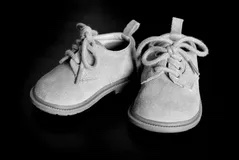 I remember my mom discussing how to spend the “baby bonus” and that it had to be on something worthwhile. She lamented that inflation in the 1970’s had eroded some of the spending power. While she used to be able to buy shoes or clothes for us when we were babies by the time we were pre-teens the money didn’t go very far.
I remember my mom discussing how to spend the “baby bonus” and that it had to be on something worthwhile. She lamented that inflation in the 1970’s had eroded some of the spending power. While she used to be able to buy shoes or clothes for us when we were babies by the time we were pre-teens the money didn’t go very far.
Just for comparison, the Canada Child Benefit, has now become the Family Allowance has become. Today children under 6 are given $570.00 per month and from 6-17 are given $480 per month. Still a nice chunk of money.
The brochure then spends a few pages explaining for the new mother how to budget wisely and make the family’s money do the most for the family. There are a lot of great practical tips like:
- it is okay to splurge on some things if you are frugal on most things.
- Quality not just price are key to getting the most for your money.
- Children should have an allowance and bank account as soon as they are able to manage it to learn about making good money choices. They should pay for haircuts or movies.
- Buy the best quality you can afford, don’t be fooled by ad campaigns.

- Don’t buy things just because they are on sale.
- Buy two pairs of shoes at once if you can, they will last longer than any two pairs purchased alone.
- Plan your menu in advance including using leftovers.
- Be sure you are meeting Food Guide Rules.
- Save cooking water, bones and scraps for soups and sauces.
- Buy in bulk and in season to save the most.
- Can and preserve when things are in season and cheaper.
- A cheaper cut of meat is just as nutritious as a more expensive one.
- Fruit that is imperfect is just as good as Grade A fruit.
- Figure out how to cook your meals to preserve the nutrition in it and make them taste best.
 There is a cute little story about a boy who desperately wants a bicycle but there isn’t enough money in the budget to buy it right away. “The 13 year old wanted the bicycle above everything in life at that moment. ” The parents talk about it and mother offers up the money she has squirreled away for a new carpet, because the carpet can wait but the boy deserves a bicycle. So they buy the boy his bike. The boy is thrilled. But it is important to his father that the boy understands that bicycles don’t grow on trees and that he should be grateful to his mother who made it possible. After the first day out riding his new bike, father asks his son, “Did you have a good ride on your mother’s carpet?”
There is a cute little story about a boy who desperately wants a bicycle but there isn’t enough money in the budget to buy it right away. “The 13 year old wanted the bicycle above everything in life at that moment. ” The parents talk about it and mother offers up the money she has squirreled away for a new carpet, because the carpet can wait but the boy deserves a bicycle. So they buy the boy his bike. The boy is thrilled. But it is important to his father that the boy understands that bicycles don’t grow on trees and that he should be grateful to his mother who made it possible. After the first day out riding his new bike, father asks his son, “Did you have a good ride on your mother’s carpet?”
Another paragraph that made me smile in another way was;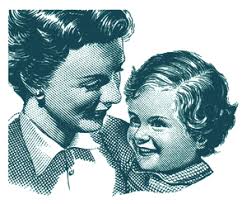
So you are going to have a baby. You are lucky. It is a wonderful experience and while bringing up a child is no easy job, it is one of the most exciting and worthwhile things that anyone can do. There is no career as important as motherhood, none more rewarding.
And then advice for new mothers:
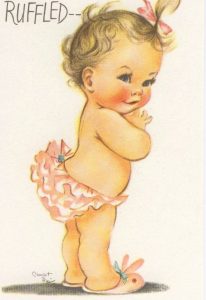 You should always remember that your child has a personality in his own right. He has psychological needs, mental, emotional and spiritual needs just much as physical needs. Behavioural difficulties are best managed if you can find out the cause behind them. It is helpful to know what kinds of behaviours are normal for certain ages.
You should always remember that your child has a personality in his own right. He has psychological needs, mental, emotional and spiritual needs just much as physical needs. Behavioural difficulties are best managed if you can find out the cause behind them. It is helpful to know what kinds of behaviours are normal for certain ages.
The book goes on to give five pages of practical advice about pregnancy, following doctor’s advice, raising babies, seeing a dentist, preventing disease, and getting vaccines. There is a multi-page list of illnesses and accidents and how to deal with them. Some of the advice is not best practice today. For example, for sunburn they suggest that you apply oil or a paste of baking soda and flour, today we would apply aloe vera gel. Another example, if your child drinks lysol they suggest to induce vomiting, give milk and castor oil and an enema today we would contact the poison control centre instead.
I found it a very interesting document, showing some of the beliefs and household wisdom of this mid-century time. While some of it is outdated, I think if I had been a new housewife in 1949 I would have found it very helpful in organizing my home and family life. Especially since the internet was 50 years away.
I wonder if government documents as helpful as this are still published?
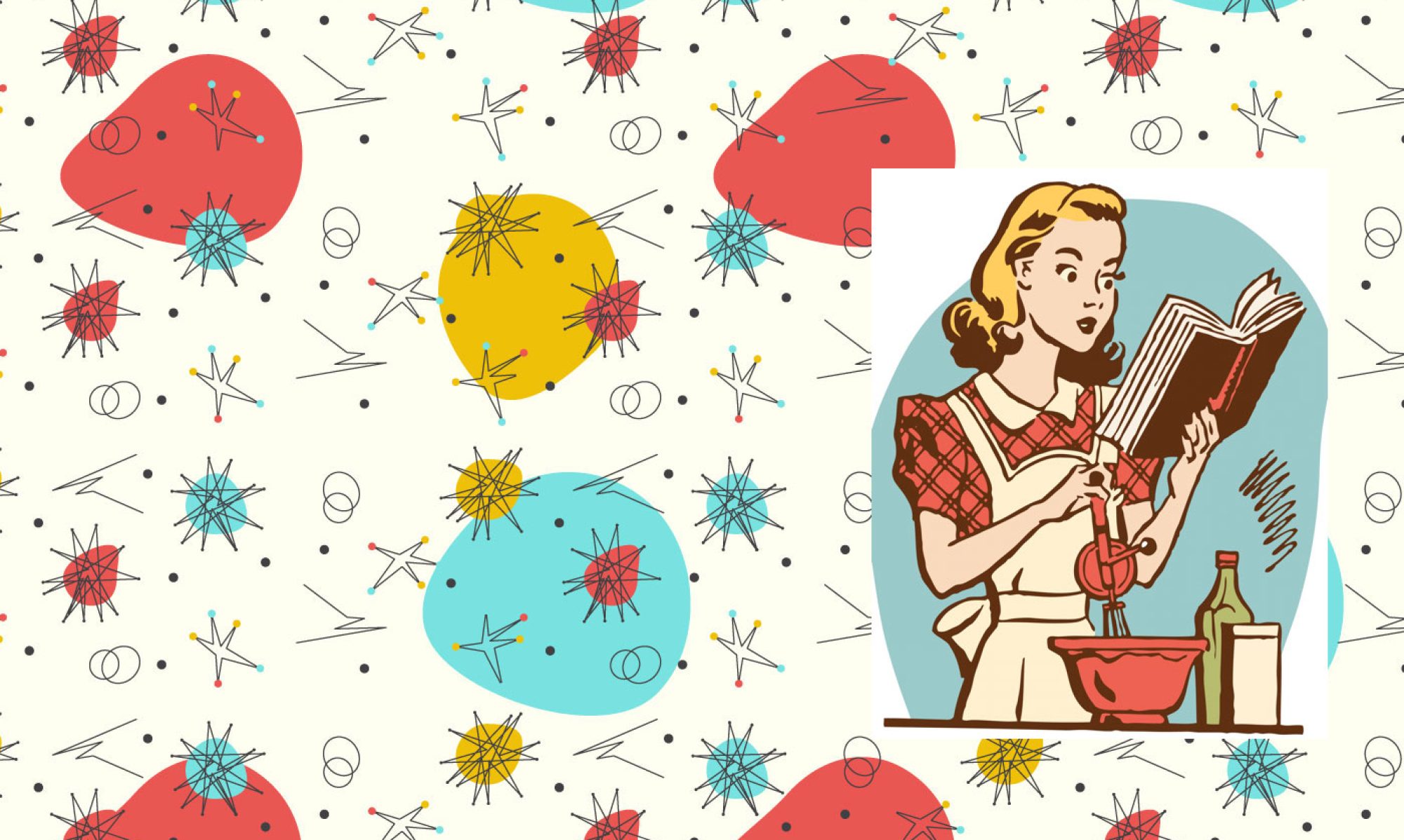
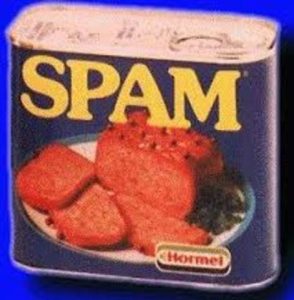 I may not be the right person to write this post. To me, meat in a can is not very appealing. I took a packed lunch everyday to school and just plain got sick of all the variations on a sandwich. So, I am not a fan of tuna or salmon and less of a fan of spam and corned beef. I also do not like bologna and most hotdogs. Therefore, I would have to be really hungry to consider meat from a can. That being said, canned meat has been and continues to be popular with many, many other people, maybe you!
I may not be the right person to write this post. To me, meat in a can is not very appealing. I took a packed lunch everyday to school and just plain got sick of all the variations on a sandwich. So, I am not a fan of tuna or salmon and less of a fan of spam and corned beef. I also do not like bologna and most hotdogs. Therefore, I would have to be really hungry to consider meat from a can. That being said, canned meat has been and continues to be popular with many, many other people, maybe you!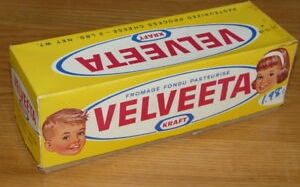
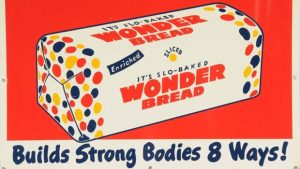
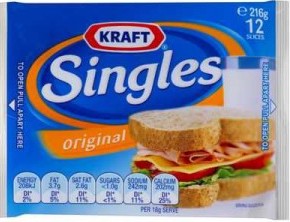 It is only logical then that pre-made, processed foods became more ubiquitous and popular as the mid-century era went on. As children my brother and I loved Kraft cheese slices, or more accurately cheese product. I remember there being a big deal about not calling it cheese in TV ads as it had all kinds of ingredients that regular cheese did not. Cheez Whiz and cheese slices were family favourites. Any of these “processed cheese foods” were great on soft squishy white
It is only logical then that pre-made, processed foods became more ubiquitous and popular as the mid-century era went on. As children my brother and I loved Kraft cheese slices, or more accurately cheese product. I remember there being a big deal about not calling it cheese in TV ads as it had all kinds of ingredients that regular cheese did not. Cheez Whiz and cheese slices were family favourites. Any of these “processed cheese foods” were great on soft squishy white  Wonderbread. Wonderbread was so soft that as a child you could easily squash it all out of shape carrying the loaf from the bread box to the table. I find that kind of bread really gummy and tasteless now but we loved it in sandwiches of all kinds in the early 1970’s. I just saw Wonderbread in a store today, although most of the packages clearly state they have added fibre. I didn’t dare squeeze it and risk squishing the loaf to the point where I might have to buy it!
Wonderbread. Wonderbread was so soft that as a child you could easily squash it all out of shape carrying the loaf from the bread box to the table. I find that kind of bread really gummy and tasteless now but we loved it in sandwiches of all kinds in the early 1970’s. I just saw Wonderbread in a store today, although most of the packages clearly state they have added fibre. I didn’t dare squeeze it and risk squishing the loaf to the point where I might have to buy it!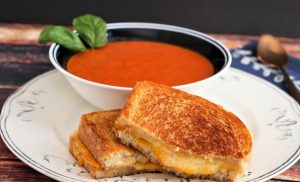 The best lunch ever, as I recall, was grilled cheese sandwiches and tomato soup. All of it processed but fast and easy to prepare and a crowd favourite even for the picky eater. A close second was Kraft Dinner macaroni
The best lunch ever, as I recall, was grilled cheese sandwiches and tomato soup. All of it processed but fast and easy to prepare and a crowd favourite even for the picky eater. A close second was Kraft Dinner macaroni 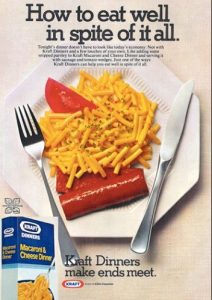 and cheese with cut up hotdogs. Just thinking about the salt, fat and chemicals in it makes me wince but we loved it. So did my mom which is why we had it fairly often.
and cheese with cut up hotdogs. Just thinking about the salt, fat and chemicals in it makes me wince but we loved it. So did my mom which is why we had it fairly often.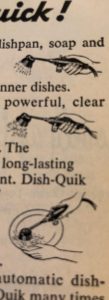 work saver was the Dish-Quick by the Dish-Quick Company. It was designed to make hand washing dishes a better experience. “The All-in-one dishwasher” is how they describe it. It is a wand that attaches to the kitchen faucet and is a spray, soap dispenser and nylon brush in one. Used with hot water it was claimed to be an efficient, sanitary and effective way to wash dishes. At $9.95 it was way more affordable than a dishwasher. Although there is not a clear picture of how it fits on the sink. I get the sense that the brush spins too, not sure.
work saver was the Dish-Quick by the Dish-Quick Company. It was designed to make hand washing dishes a better experience. “The All-in-one dishwasher” is how they describe it. It is a wand that attaches to the kitchen faucet and is a spray, soap dispenser and nylon brush in one. Used with hot water it was claimed to be an efficient, sanitary and effective way to wash dishes. At $9.95 it was way more affordable than a dishwasher. Although there is not a clear picture of how it fits on the sink. I get the sense that the brush spins too, not sure.
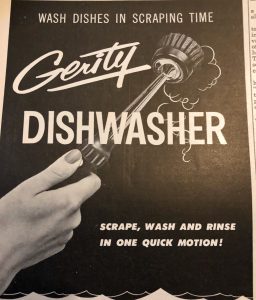 product, the Gerity Dishwasher. (Really, I don’t know who patented what first.) Gerity claimed that you can wash dishes in the time it takes to just scrape them. The normal brush is soft on fine china, but a wire brush is available for scrubbing tough stuff. Its benefits are speed in getting the dishes washed, keeping your hands out of the dishwater (no dishpan hands) and because of the high temperature rinse you could just drain the dishes on a drying rack. No drying needed. It had a higher cost at $39.95. But it was a bigger piece of equipment that screwed into the faucet.
product, the Gerity Dishwasher. (Really, I don’t know who patented what first.) Gerity claimed that you can wash dishes in the time it takes to just scrape them. The normal brush is soft on fine china, but a wire brush is available for scrubbing tough stuff. Its benefits are speed in getting the dishes washed, keeping your hands out of the dishwater (no dishpan hands) and because of the high temperature rinse you could just drain the dishes on a drying rack. No drying needed. It had a higher cost at $39.95. But it was a bigger piece of equipment that screwed into the faucet.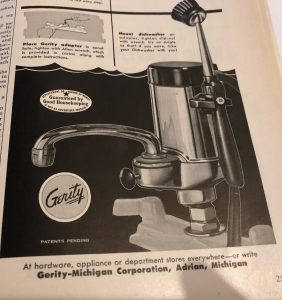
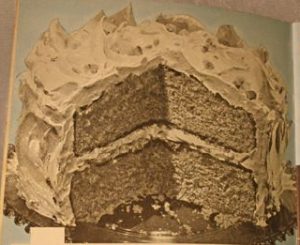 Before Pillsbury was known for its refrigerator dough it was a flour brand. That makes sense now that I know it. They had Grand National Recipe and Baking Contests starting in 1950. One winner that caught my eye was Prune Whip Spice Cake which won the $1000 prize. Prunes are not something that I really associate with cakes or any kind of baking. But this recipe won the big prize in 1955 so its worth a look. I will warn you that it has some complicated steps.
Before Pillsbury was known for its refrigerator dough it was a flour brand. That makes sense now that I know it. They had Grand National Recipe and Baking Contests starting in 1950. One winner that caught my eye was Prune Whip Spice Cake which won the $1000 prize. Prunes are not something that I really associate with cakes or any kind of baking. But this recipe won the big prize in 1955 so its worth a look. I will warn you that it has some complicated steps.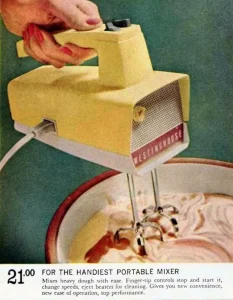 *A couple of notes : Double acting baking soda is the kind most available in grocery stores, apparently there is a single acting baking soda for commercial baking purposes but not really something you would have. And have you ever seen the number of strokes of a whisk that equals 1 1/2 minutes with an electric mixer? While stand mixers were found in many kitchens by this time, I am guessing they are assuming you have a “mix master” type of electric mixer because of what follows with the frosting.
*A couple of notes : Double acting baking soda is the kind most available in grocery stores, apparently there is a single acting baking soda for commercial baking purposes but not really something you would have. And have you ever seen the number of strokes of a whisk that equals 1 1/2 minutes with an electric mixer? While stand mixers were found in many kitchens by this time, I am guessing they are assuming you have a “mix master” type of electric mixer because of what follows with the frosting.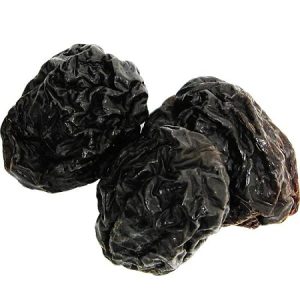
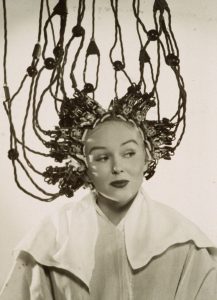 This electric hair curling gizmo is what I think of when I think about early hair curling technology. I don’t know if very many people ever got this kind of “permanent wave”. It was perhaps a novelty in the 1920’s or 1930’s when all things electricity were a fad. I wouldn’t trust that my hair would survive this treatment.
This electric hair curling gizmo is what I think of when I think about early hair curling technology. I don’t know if very many people ever got this kind of “permanent wave”. It was perhaps a novelty in the 1920’s or 1930’s when all things electricity were a fad. I wouldn’t trust that my hair would survive this treatment.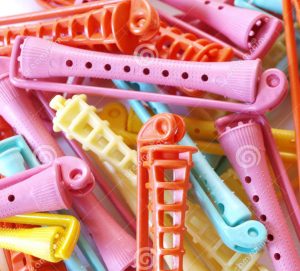 remember the horrid smell. I am guessing that is the ammonia in the activator. I also recall the coldness of the lotion followed up soon after by the burning on the scalp. I remember that perms usually had four steps, rolling the hair onto rods and papers, squirting the activator onto the hair, waiting 15 minutes or so and then putting the neutralizer on, then rinsing with water. I clearly remember the cold lotions trickling down my scalp and sometimes neck. I had many perms as a kid and teen, usually in a beauty salon not from home kits. I remember that you had to be careful using perms if you had coloured hair, as your hair could be fried. Again I am guess that is the ammonia from the perms adding to the ammonia to the hair dye. And although perms are considered passe now, I will say they made hairstyling a lot easier than with natural hair. The photo shows a hairstyle similar to the perm-requiring one I wore in 1977. Although my hair never had that volume!
remember the horrid smell. I am guessing that is the ammonia in the activator. I also recall the coldness of the lotion followed up soon after by the burning on the scalp. I remember that perms usually had four steps, rolling the hair onto rods and papers, squirting the activator onto the hair, waiting 15 minutes or so and then putting the neutralizer on, then rinsing with water. I clearly remember the cold lotions trickling down my scalp and sometimes neck. I had many perms as a kid and teen, usually in a beauty salon not from home kits. I remember that you had to be careful using perms if you had coloured hair, as your hair could be fried. Again I am guess that is the ammonia from the perms adding to the ammonia to the hair dye. And although perms are considered passe now, I will say they made hairstyling a lot easier than with natural hair. The photo shows a hairstyle similar to the perm-requiring one I wore in 1977. Although my hair never had that volume!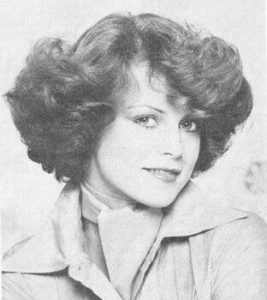
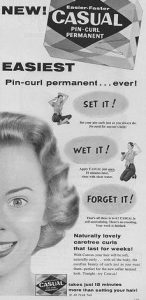 My mom had perms for decades. It seems like lots of mid-century housewives did too. They definitely would have helped keep the curly roller set hairstyles in place for longer. There are many advertisements for home permanents mid-century. One from 1955 is called Casual Pin-Curl Permanent. The ad shows a young woman with short hair. The instructions say just put your hair up in pin curls, apply Casual solution, wait for 15 minutes, rinse with water and you are finis
My mom had perms for decades. It seems like lots of mid-century housewives did too. They definitely would have helped keep the curly roller set hairstyles in place for longer. There are many advertisements for home permanents mid-century. One from 1955 is called Casual Pin-Curl Permanent. The ad shows a young woman with short hair. The instructions say just put your hair up in pin curls, apply Casual solution, wait for 15 minutes, rinse with water and you are finis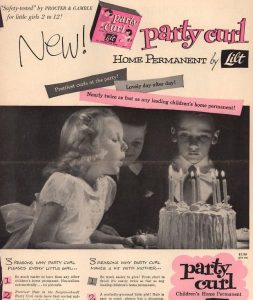 In another ad from 1955, we see there was even a special formula for children. Lilt Party Curl Children’s home permanent
In another ad from 1955, we see there was even a special formula for children. Lilt Party Curl Children’s home permanent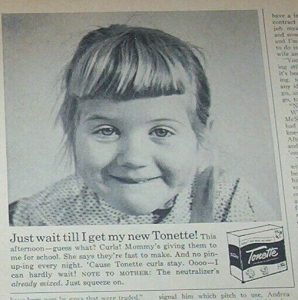 Tonette was another children’s home perm kit. The home kits for mothers were called the Toni home permanent. In the ad to the left, this girl looks a bit dishevelled but I think she is already a cute girl . But there was a clear theme to these ads; curly hair makes you prettier. The mid-century certainly had a very feminine aesthetic, for young and old.
Tonette was another children’s home perm kit. The home kits for mothers were called the Toni home permanent. In the ad to the left, this girl looks a bit dishevelled but I think she is already a cute girl . But there was a clear theme to these ads; curly hair makes you prettier. The mid-century certainly had a very feminine aesthetic, for young and old.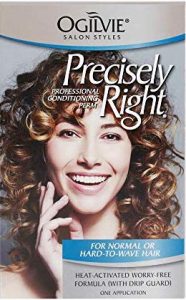
 Mid-century sources often spell it cocoanut and they mean the dried often sweetened shredded or flaked form not the fresh whole fruit we can get now. From my research coconut was part of the “tropics craze” that brought exotic fruit like canned pineapple to grocery shelves and home pantries in the mid-century.
Mid-century sources often spell it cocoanut and they mean the dried often sweetened shredded or flaked form not the fresh whole fruit we can get now. From my research coconut was part of the “tropics craze” that brought exotic fruit like canned pineapple to grocery shelves and home pantries in the mid-century.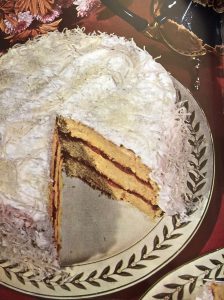 In my growing collection of mid-century cookbooks one of the recurring recipes is a confection of a dessert called something like “Snowball Cake”. It usually had pride of place in the colour page(s) of the book. Basically you just ice the cake with a thick coat of frosting and then press coconut into the frosting. A crowd pleaser, I bet.
In my growing collection of mid-century cookbooks one of the recurring recipes is a confection of a dessert called something like “Snowball Cake”. It usually had pride of place in the colour page(s) of the book. Basically you just ice the cake with a thick coat of frosting and then press coconut into the frosting. A crowd pleaser, I bet. Coconut Macaroons:
Coconut Macaroons: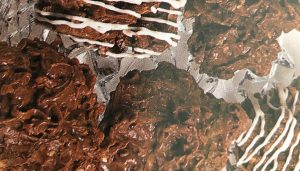
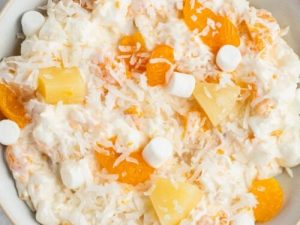

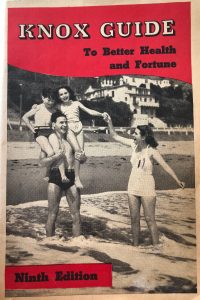 I love old books, especially the weird ones. The Knox Guide to Better Health and Fortune is really a weird one. I first thought it was going to be about how Knox Gelatin could change your life, but it wasn’t. It is published by the Knox Company of Fort Erie North, Ontario. (They also say they have offices in London(England), Melbourne, Bombay and Johannesburg.) My version doesn’t have a publishing date but is the ninth edition. Research by my husband tells us it was published before 1947.
I love old books, especially the weird ones. The Knox Guide to Better Health and Fortune is really a weird one. I first thought it was going to be about how Knox Gelatin could change your life, but it wasn’t. It is published by the Knox Company of Fort Erie North, Ontario. (They also say they have offices in London(England), Melbourne, Bombay and Johannesburg.) My version doesn’t have a publishing date but is the ninth edition. Research by my husband tells us it was published before 1947.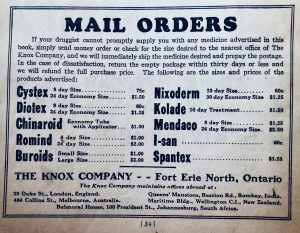 It is a little 36 page yellowed newsprint pamphlet full of ads for the same 10 Knox Company health products advertised over and over again along with some sage or not so sage advice about your fortune.
It is a little 36 page yellowed newsprint pamphlet full of ads for the same 10 Knox Company health products advertised over and over again along with some sage or not so sage advice about your fortune.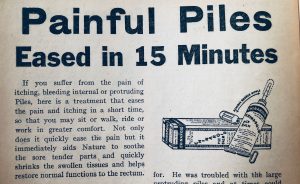 The ads now seem very wordy with claims of dramatic cures, much like snake oil of the Victorian era. The ten Knox Company products are:
The ads now seem very wordy with claims of dramatic cures, much like snake oil of the Victorian era. The ten Knox Company products are: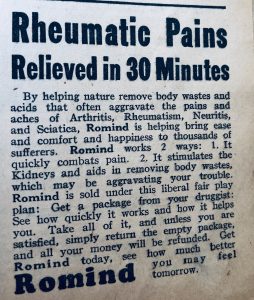 Chinaroid– applicator of balm cream to ease pile (hemorrhoid) pain and itching, shrink sore swollen tissues and help healing
Chinaroid– applicator of balm cream to ease pile (hemorrhoid) pain and itching, shrink sore swollen tissues and help healing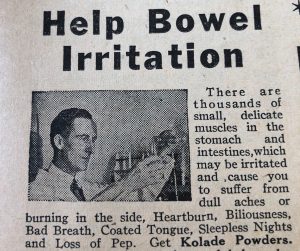 Kolade-powder to relieve stomach and bowel irritation that causes heartburn, gas, loss of energy and poor sleep by soothing and relaxing muscles and mucus membranes
Kolade-powder to relieve stomach and bowel irritation that causes heartburn, gas, loss of energy and poor sleep by soothing and relaxing muscles and mucus membranes loss of hearing due to inflammation of the ears, sinuses, tissues around the ears and eustachian tubes. )
loss of hearing due to inflammation of the ears, sinuses, tissues around the ears and eustachian tubes. )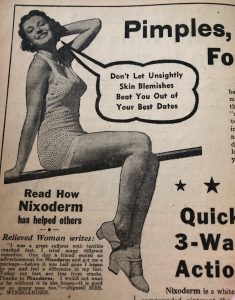 psoriasis, eczema and other rashes including athlete’s foot. Fun fact, something called Nixoderm is still sold by the Johnson company and is available on Amazon. I am not sure if it is the same formula, although the packaging looks very similar.
psoriasis, eczema and other rashes including athlete’s foot. Fun fact, something called Nixoderm is still sold by the Johnson company and is available on Amazon. I am not sure if it is the same formula, although the packaging looks very similar.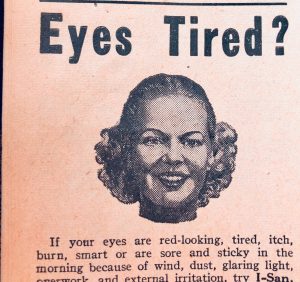 In every ad they stress how quickly and effectively the treatments work. A money-back guarantee is offered on everything.
In every ad they stress how quickly and effectively the treatments work. A money-back guarantee is offered on everything.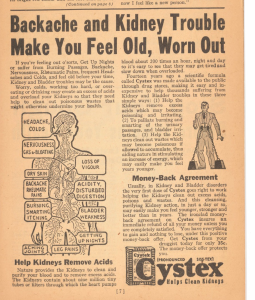
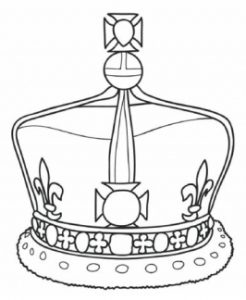 I heard a cute story Charles has been reported to have shared about how he started to realize as a small child that his mother wasn’t a typical mother when in the weeks prior to her coronation she would pop into the nursery for her evening visit wearing the coronation crown. She was getting used to wearing the heavy crown in her off time. (She probably had to strengthen her neck muscles as the crown weighs about 2.5 kg) That apparently meant wearing it even when the nanny was giving the kids a bath. I agree that is not typical, my mom never wore a crown around the house and certainly wouldn’t trust us not to accidentally splash the crown and ruin it.
I heard a cute story Charles has been reported to have shared about how he started to realize as a small child that his mother wasn’t a typical mother when in the weeks prior to her coronation she would pop into the nursery for her evening visit wearing the coronation crown. She was getting used to wearing the heavy crown in her off time. (She probably had to strengthen her neck muscles as the crown weighs about 2.5 kg) That apparently meant wearing it even when the nanny was giving the kids a bath. I agree that is not typical, my mom never wore a crown around the house and certainly wouldn’t trust us not to accidentally splash the crown and ruin it.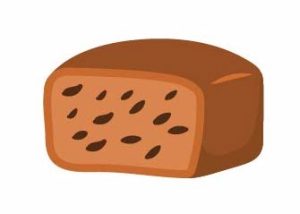 Coronation Cake
Coronation Cake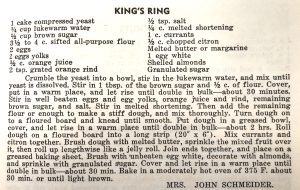
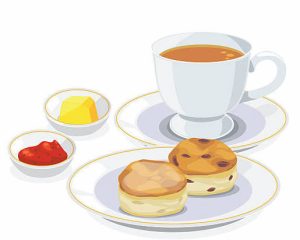
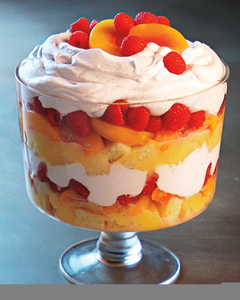
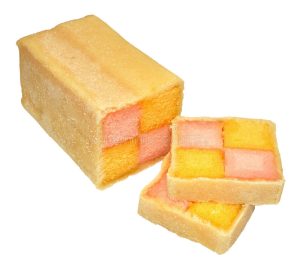 By the way, Battenburg cake is a classic British dessert on its own. It comes from the late Victorian age. As you can see from the picture it is made of two kinds of cake cut into long rectangular pieces and put back together with jam or icing into this checkerboard pattern. The outside icing is made with marzipan, stiff enough to hold all of the pieces together.
By the way, Battenburg cake is a classic British dessert on its own. It comes from the late Victorian age. As you can see from the picture it is made of two kinds of cake cut into long rectangular pieces and put back together with jam or icing into this checkerboard pattern. The outside icing is made with marzipan, stiff enough to hold all of the pieces together.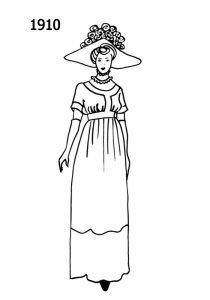
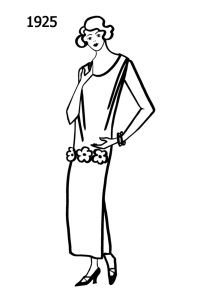
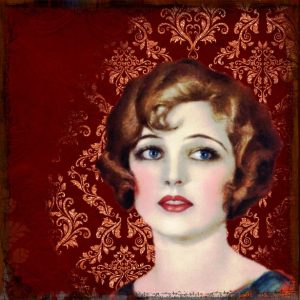 And so we have the Flapper who broke all the old fashion rules. She cut her hair, wore flashy scanty clothing, smoked cigarettes, danced the Charleston and even wore makeup. The makeup was rather crude by our standards today. It was also quite expensive. There was powder, mascara, rouge and lipstick. There weren’t a lot of colour options available and I think Flappers applied it all rather heavy handedly and they over plucked their brows. But it was a new beauty standard. Again, it was shocking at the time.
And so we have the Flapper who broke all the old fashion rules. She cut her hair, wore flashy scanty clothing, smoked cigarettes, danced the Charleston and even wore makeup. The makeup was rather crude by our standards today. It was also quite expensive. There was powder, mascara, rouge and lipstick. There weren’t a lot of colour options available and I think Flappers applied it all rather heavy handedly and they over plucked their brows. But it was a new beauty standard. Again, it was shocking at the time.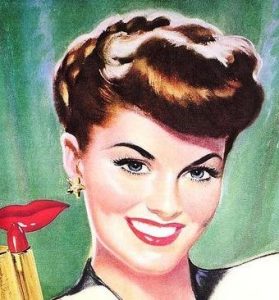 By the 1940’s and the Second World War, being concerned about looking your best in public was expected. Magazines were full of ads for hair products, skin care creams and cosmetics. The formulas for makeup improved to be kinder to the skin and colours became more available to suit more women. (Still not exactly inclusive of all women.) Eyebrows became stronger and more naturally shaped. The overall look was one of health and youth and a lighter hand was favoured. Women often only wore lipstick, and could use it as a blush on cheeks as well. During the war cosmetics were often difficult to find once again. But women made do.
By the 1940’s and the Second World War, being concerned about looking your best in public was expected. Magazines were full of ads for hair products, skin care creams and cosmetics. The formulas for makeup improved to be kinder to the skin and colours became more available to suit more women. (Still not exactly inclusive of all women.) Eyebrows became stronger and more naturally shaped. The overall look was one of health and youth and a lighter hand was favoured. Women often only wore lipstick, and could use it as a blush on cheeks as well. During the war cosmetics were often difficult to find once again. But women made do. In the 1950’s eyeshadows and false lashes were frequently used for dramatic evening looks. A somewhat smudged smoky eye was popular. Everyday makeup was still very natural looking. Powder, rouge and lipstick was all you needed. My mother said women never left home without at least lipstick on. Something that I had noticed was that a popular shade of lipstick was an orange-red. You see these red shades being offered in ads in all the magazines of the time. What I found out was movie stars like Marilyn Monroe wore this orange-red shade because it showed up as a rich red on the movie film used at this time. I think this shade is not as flattering as a cherry red, but maybe that is just my preference. I would not have been happy with this shade if I lived in the 1950’s.
In the 1950’s eyeshadows and false lashes were frequently used for dramatic evening looks. A somewhat smudged smoky eye was popular. Everyday makeup was still very natural looking. Powder, rouge and lipstick was all you needed. My mother said women never left home without at least lipstick on. Something that I had noticed was that a popular shade of lipstick was an orange-red. You see these red shades being offered in ads in all the magazines of the time. What I found out was movie stars like Marilyn Monroe wore this orange-red shade because it showed up as a rich red on the movie film used at this time. I think this shade is not as flattering as a cherry red, but maybe that is just my preference. I would not have been happy with this shade if I lived in the 1950’s.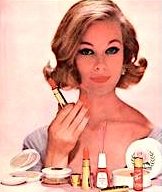 The 1960’s were as revolutionary as the 1920’s in many ways. The prevailing ways of dressing, wearing your hair and wearing makeup , changed a lot over the decade. Think about how decades of wearing similarly styled dresses in the thirties, forties and fifties gradually became out of fashion and young women started to wear slim fitted suits, then miniskirts and pantsuits and finally jeans and peasant skirts. By the 1960’s a whole world of colour for makeup also opened up. Foundation, powder, blush and lipstick was typical for everyday wear. As was eyeshadow in much bolder colours. We have all seen the bright blue and green eyeshadow trend that started in the sixties and lasted a long while . In fact the first pallette of eyeshadow I every bought in the mid 1970’s was four pans; baby blue, baby green, white and black. Imagine how you could muck that up in your first try at eyeshadow. Blush and lipstick colour ranges increased too, and shades of pink became popular. Almost any shade of blush and lipcolour you can imagine is available by the 1970’s.
The 1960’s were as revolutionary as the 1920’s in many ways. The prevailing ways of dressing, wearing your hair and wearing makeup , changed a lot over the decade. Think about how decades of wearing similarly styled dresses in the thirties, forties and fifties gradually became out of fashion and young women started to wear slim fitted suits, then miniskirts and pantsuits and finally jeans and peasant skirts. By the 1960’s a whole world of colour for makeup also opened up. Foundation, powder, blush and lipstick was typical for everyday wear. As was eyeshadow in much bolder colours. We have all seen the bright blue and green eyeshadow trend that started in the sixties and lasted a long while . In fact the first pallette of eyeshadow I every bought in the mid 1970’s was four pans; baby blue, baby green, white and black. Imagine how you could muck that up in your first try at eyeshadow. Blush and lipstick colour ranges increased too, and shades of pink became popular. Almost any shade of blush and lipcolour you can imagine is available by the 1970’s.